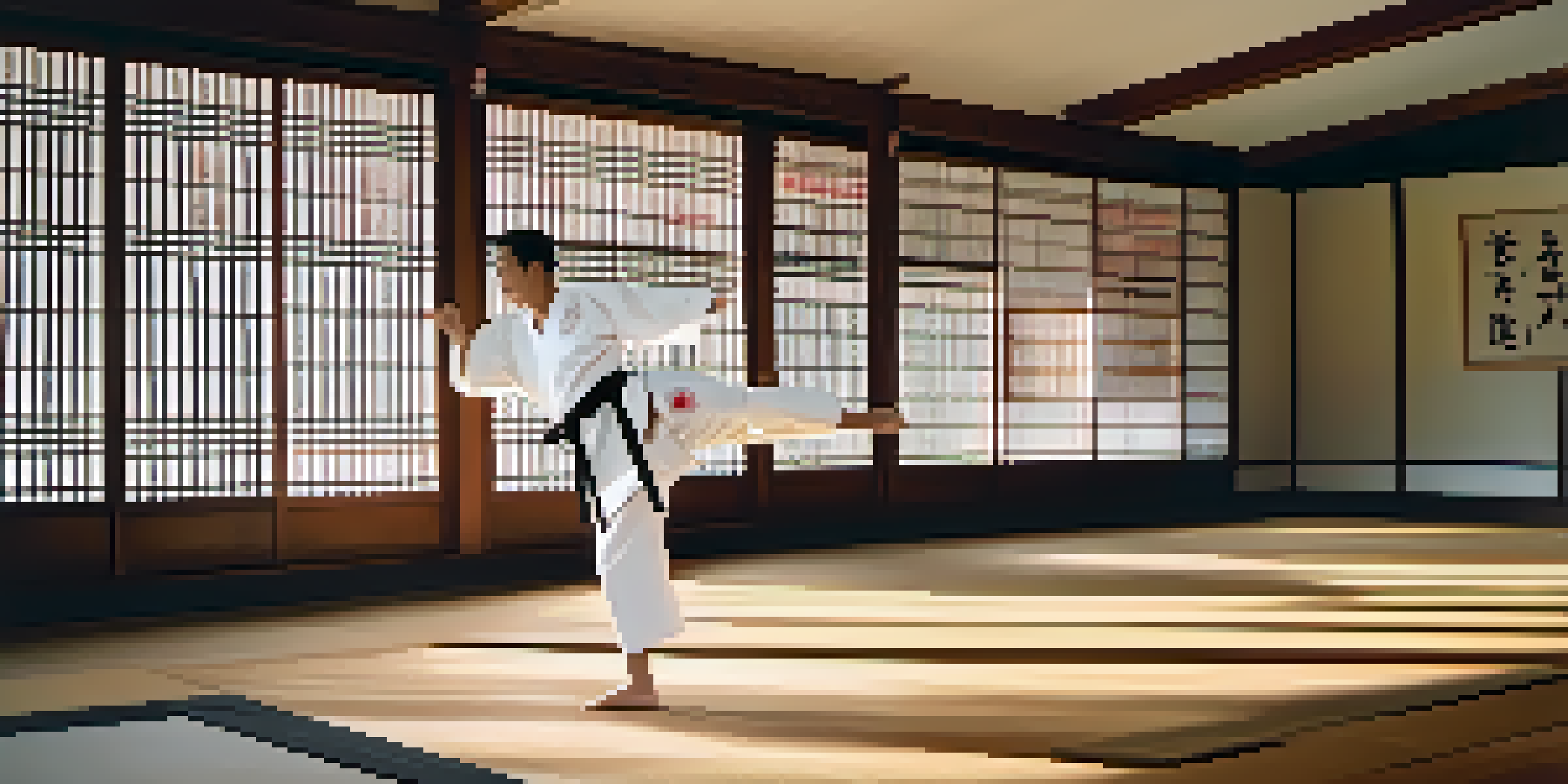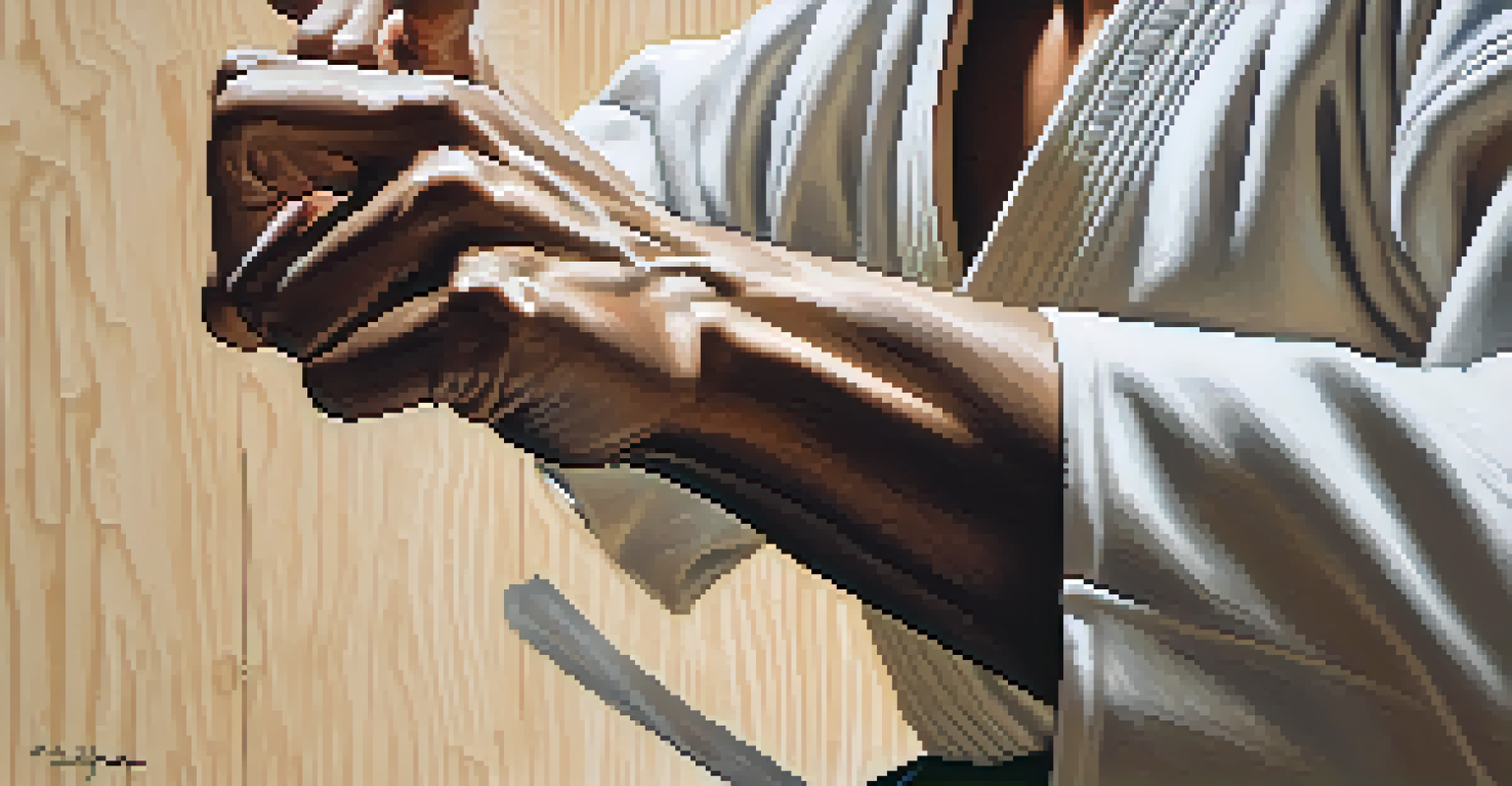Karate Techniques: The Art of Striking and Self-Defense Skills

Understanding the Basics of Karate Techniques
Karate is more than just a collection of punches and kicks; it’s a discipline that combines physical skill with mental focus. At its core, karate techniques are designed to enhance both striking and self-defense capabilities. Whether you're a beginner or seasoned practitioner, mastering the basics is essential for effective execution of more advanced techniques.
The ultimate aim of karate lies not in victory or defeat, but in the perfection of the character of its participants.
Fundamental moves such as stances, blocks, and strikes form the foundation of karate practice. These basics help practitioners develop coordination, balance, and timing, which are crucial for executing techniques efficiently. Think of these foundational skills as the building blocks upon which you can construct a strong martial arts repertoire.
As you progress, these basic techniques become more intuitive, allowing you to focus on strategy and fluidity during practice. Regular training not only improves your physical abilities but also boosts your confidence and mental resilience. In karate, the journey is just as important as the destination.
Striking Techniques: The Power of Punches and Kicks
Striking techniques in karate include a variety of punches, kicks, and knee strikes, each with its own purpose and application. For instance, the jab and cross are fundamental punches that can be used to create distance or set up more powerful strikes. Similarly, front kicks and roundhouse kicks serve different roles, from quick jabs to powerful attacks.

Understanding the mechanics behind each strike is crucial for maximizing their effectiveness. Proper technique not only increases power but also helps prevent injury. For example, aligning your hips and shoulders correctly when throwing a punch can significantly improve your striking force while maintaining balance.
Karate: A Holistic Discipline
Karate combines physical techniques with mental focus, promoting personal development beyond just martial arts skills.
Practicing these strikes with a partner or on a heavy bag can help you refine your technique and build muscle memory. Over time, you'll discover which strikes work best for you and how to combine them seamlessly during sparring or self-defense situations. Remember, striking is not just about power; it’s about precision and timing.
Blocking Techniques: The First Line of Defense
In karate, blocking techniques are essential for protecting yourself from an opponent's strikes. Blocks not only defend against attacks but also set up counter-attacks, making them a critical component of any self-defense strategy. Common blocks include the rising block, inward block, and downward block, each designed to deflect specific types of strikes.
Karate is a form of self-defense and self-improvement. It teaches you to protect yourself and to be the best version of yourself.
Learning to block effectively requires practice and awareness. It’s important to not only react quickly but also to anticipate your opponent's moves. This anticipatory skill can be likened to a dance, where partners must be in sync to avoid missteps and keep the flow going.
Mastering blocking techniques will enhance your overall defensive capabilities, allowing you to remain calm under pressure. The more proficient you become at blocking, the more confident you will feel in your ability to handle confrontations, whether in practice or real-life scenarios.
Kata: The Art of Form and Movement
Kata, a series of choreographed movements, plays a pivotal role in karate training, serving as a way to practice techniques in a structured manner. Each kata presents a sequence of movements that simulate combat scenarios, allowing practitioners to refine their skills and internalize techniques. Think of kata as a dance routine that tells a story, with each move representing a defensive or offensive action.
Practicing kata helps improve rhythm, balance, and coordination, as well as mental concentration. By repeating these movements, karateka (karate practitioners) develop a deeper understanding of technique application and timing. It’s through kata that the principles of karate begin to come alive, transforming abstract moves into practical skills.
Striking and Blocking Techniques
Mastering striking and blocking techniques is essential for effective self-defense and improving overall martial arts performance.
Moreover, kata is often used in competitions, showcasing a practitioner's understanding and execution of techniques. This competitive aspect adds an extra layer of motivation, pushing practitioners to perfect their forms and embody the spirit of karate. In essence, kata is not just a physical exercise; it’s a holistic practice that nurtures both body and mind.
Self-Defense Skills: Practical Techniques for Real-Life Situations
Karate isn’t just about competition; it’s also a powerful tool for self-defense. Self-defense training incorporates techniques that can be applied in real-life situations, focusing on practical skills that help you protect yourself. From simple strikes to escaping holds, these techniques are designed to empower individuals and enhance their confidence in potentially dangerous scenarios.
One of the key aspects of self-defense in karate is situational awareness. Being aware of your surroundings can often prevent confrontations from escalating. It’s about recognizing potential threats and knowing how to respond effectively, whether that means walking away or preparing to defend yourself.
Training for self-defense builds not only physical skills but also mental preparedness. Practicing scenarios with a partner can help simulate high-stress situations, allowing you to react instinctively rather than overthinking your response. Ultimately, the goal of self-defense training is to equip you with the tools you need to ensure your safety while instilling a sense of confidence in your abilities.
The Mental Aspect of Karate: Focus and Discipline
Beyond physical techniques, karate places a strong emphasis on mental discipline and focus. Practitioners learn to cultivate a mindset that values respect, perseverance, and self-control. This mental aspect is what differentiates karate from other forms of physical exercise, making it a holistic practice for personal development.
Meditation and breathing exercises are often incorporated into training to help enhance mental clarity and focus. Just as athletes visualize their performance, karate practitioners are encouraged to mentally rehearse techniques and scenarios. This mental training can help reduce anxiety and improve overall performance, both on and off the mat.
Continuous Growth in Karate
Karate encourages a lifelong journey of learning and self-improvement, where each rank symbolizes progress and new challenges.
As you grow in your karate journey, you'll find that the mental benefits extend into daily life. Skills such as patience, resilience, and concentration can be applied to various situations outside of the dojo, helping you navigate challenges with a calm and composed demeanor. In essence, karate serves as a powerful teacher, shaping not just skilled martial artists but well-rounded individuals.
The Journey of Continuous Improvement in Karate
Karate is a lifelong journey of learning and self-improvement. Unlike many sports that focus solely on competition, karate encourages practitioners to embrace the process of growth and development. Each belt represents not just a rank but a milestone in your journey, symbolizing the knowledge and skills you’ve acquired along the way.
As you progress through the ranks, you'll encounter new challenges that push you out of your comfort zone. This continuous improvement fosters a growth mindset, where obstacles are viewed as opportunities to learn rather than setbacks. Just like climbing a mountain, each step brings you closer to the summit, revealing new perspectives and insights along the way.

The beauty of karate lies in its ability to adapt and evolve with you. Whether you’re focused on perfecting a technique, mastering kata, or improving your self-defense skills, there’s always something new to learn. This journey not only enhances your martial arts abilities but also enriches your life, making karate a fulfilling practice for years to come.